"We are what we repeatedly do. Excellence, then, is not an act, but a habit." --Aristotle
Address any questions or comments regarding this newsletter to the individual authors listed after each article or to its editor, Rick Weinzierl, 217-333-6651, weinzier@illinois.edu. To receive e-mail notification of new postings of this newsletter, call or write the same number or address.
In This Issue:
Open positions for Local Food Systems and Small Farms Educators and Horticulture Educators
Regional Observations (from Mike Roegge, Kyle Cecil, and Ellen Phillips)
Fruit Production and Pest Management (updates and notes on oriental fruit moth and codling moth, spotted wing Drosophila, Japanese beetle)
Vegetable Production and Pest Management (corn earworm, squash bug and squash vine borer, Colorado potato beetle, bean leaf beetles and western corn rootworm beetles)
Local Foods Issues (high tunnel end walls, traceability and recalls, rodents and food safety)
Upcoming Programs
Check the Illinois SARE calendar for a full list of programs and links for registration.
http://illinoissare.org/ and http://illinoissare.org/calendar.php
Also see the University of Illinois Extension Local Food Systems and Small Farms Team’s web site at:
http://web.extension.illinois.edu/smallfarm/
- First Annual Illinois Organic Fest, July 21, 2013, 6:00 p.m., Prairie Fruits Farm, Champaign, IL. Pre-register at http://illinois-organic-fest.eventbrite.com. (Walk-ins accepted only if space is available; capacity is 100 people; you must arrive by 6:15 to guarantee your pre-registered space). Bring a local food dish to share at the potluck. Lemonade, iced tea, and water will be provided. Admission is free. For more information, email illinoisorganicgrowers@gmail.com or call 217-528-1563 (IOGA c/o the IL Stewardship Alliance).
- Roots to Rooftop Tour, July 28, 2013, 1:00-4:00 p.m. A school garden, a roof-top garden, and other neighborhood and community gardens will be the featured stops on an upcoming urban agriculture and garden tour throughout the Springfield area. For more information, see http://web.extension.illinois.edu/units/event.cfm?UnitID=629&EventID=62221.
- Aronia Berry Field Day, August 28, 2013, 9:30 a.m. – noon. Coldbrook Farm, 16952 E 6000N Road, Momence, IL 60954. Register for this free event by calling University of Illinois Extension, Kankakee County at 815-933-8337 by August 27, 2013. For additional information, please email aronia.us@att.net or jtheu50@illinois.edu or visit www.coldbrookfarm.net.
Open positions for Local Food Systems and Small Farms Educators and Horticulture Educators
University of Illinois Extension is seeking applicants for Extension Educators in positions focused on local food systems and small farms and positions focused on horticulture.
For the Local Food Systems and Small Farms positions, see U of I Extension (A1300280), http://go.illinois.edu/A1300280. The locations for these positions are …
Unit 4 (100%): Carroll, Lee, and Whiteside counties
Unit 12 (100%): Livingston, McLean, and Woodford counties
Unit 20 (50% shared with Unit 21): Clark, Crawford, and Edgar counties
Unit 21 (50% shared with Unit 20): Clay, Effingham, Fayette, and Jasper counties
Unit 24 (100%): Gallatin, Hamilton, Hardin, Pope, Saline, and White counties
Additional positions may become available in other locations
For the Horticulture positions, see U of I Extension (A1300281) http://go.illinois.edu/A1300281. The locations for these positions are …
Unit 13: Champaign, Ford, Iroquois, and Vermilion counties
Unit 15: Calhoun, Cass, Greene, Morgan, and Scott counties
Additional positions may become available in other locations.
To receive full consideration, all requested application materials for these positions must be submitted via the online system by the closing date of July 24, 2013.
Regional Observations
From western Illinois ...
What’s the saying about if you don’t like the weather today, just wait until next week and it will change? Not that long ago we were wondering if it would ever stop raining, and now we’re hoping for a shower! Soils are as hard as rock due to the earlier heavy pounding rains on saturated soils. I’m hoping we’re not setting up another 2011, when the last good rain we had was on June 26, and from then until mid-October I recorded only 2” of moisture.
The soil is extremely hard and any tillage results in large chunks of soil. Cracks are appearing and lawns are looking a little brownish. Younger corn on clay hillsides and end rows has been rolling in the heat, trying to conserve moisture.
The first sweet corn is being harvested. Stands are variable, depending upon planting date and how soon after planting the rains fell. Many other seeded crops (and some transplants) suffered the same fate of poor stands or replant due to heavy rains. I’ve noted much more deer feeding in sweet corn this year than normal … not sure if it’s because of increased deer herd numbers or just because most of the field corn is so far behind and the only ears emerged are on sweet corn.
I saw the first powdery mildew of the season on some summer squash. It seems very early in the year to find it. Guidelines for controlling Powdery mildew are included in the 2013 Midwest Vegetable Production Guide. Additionally, Dr. Mohammad Babadoost (217-333-1523; babadoos@illinois.edu) distributed a condensed version of key recommendations at several winter educational programs. Squash bugs and squash bug eggs also are present in squash and pumpkin fields … see the notes on this insect later in this issue
Corn earworm moth captures have dramatically decreased. Moth captures the first few days in July averaged 250 moths per night. Since then they’ve tapered off to single digits. We’re obviously between flights. I had a message from a sweet corn grower in IA who mentioned he had followed his regular spray application schedule and had 40% infestation in his early sweet corn. He might want to consider using a trapping program to monitor for adult populations and then using that data to better time his applications.
Aphids and mites are present in high tunnels, to varying degrees. Tomato hornworm can be found, although not in overwhelming numbers (yet).
Fungal diseases of tomatoes (early blight) were reported in field tomatoes. Red raspberry harvest has concluded, blackberry harvest is on the downhill side. The hot weather advanced the red raspberry harvest. Early peaches are starting to color, but Red Havens are still several weeks away.
Matted row strawberry production is starting to wind down, and after the final harvest, renovation should begin. If dandelions are a problem, consider applying 2,4-D (it will not harm the strawberry plant if applied immediately after the last harvest, but you
Mike Roegge (217-223-8380; roeggem@illinois.edu)
Also from western Illinois ...
Hot and humid! That pretty well describes growing conditions the last two weeks here. While these conditions make daily chores more trying, most growers are in good spirits with the way crops are progressing. First harvests from field-grown tomatoes as well as okra began 10 days ago. Early green beans have had second harvests as well. Lettuce harvest is, for the most part, complete. I was on a farm last week where the farmer has been growing various head lettuces on white plastic with row covers and those plants are doing extremely well. One of the keys to accomplishing an extension of the lettuce growing season into warmer months is variety selection. Pay particular attention to the varieties you will use in order to ensure a greater chance of success.
The dog days of summer signal the gradual transition toward another growing season. This has high tunnel growers looking toward fall. An early start to fall seeded plants help ensure adequate growth takes place prior to cool temps. For our area (western Illinois), the date that the 4 inch soil temp dropped below 80 degrees last year (optimum germination of many seeds) was August 5. Growers can determine this date for any particular area of Illinois by going to the Illinois State Water Survey’s Water and Climate Survey. Fall and winter seem a long way out, but planning for a successful growing season begins now.
As far as pests go, Japanese beetles and Colorado potato beetles are the issues of concern right now. I visited a farm last week and witnessed the worst infestation of potato beetles in my career. Luckily, the crop had progressed far enough that a healthy crop was still evident below ground. Above ground was a different story. A similar assessment can be said for the Japanese beetles on my farm visits. For example, I have Chester thornless blackberries on my farm with severe Japanese beetle leaf defoliation. While the leaves are significantly affected, the berries themselves look very good and have progressed well toward maturity and harvest. Japanese beetles are a difficult pest to manage. See the notes on this insect later in this issue.
Kyle Cecil (309-342-5108; cecil@illinois.edu)
In north central Illinois...
In north central Illinois, sunny, hot days and cooler nights have been the typical these past couple of weeks. This is changing dramatically, with expectations of temperatures over 100F later this week. Sour cherry, raspberry and blueberry harvesting is underway. June-bearing strawberry harvest is done in the region. Farmers are harvesting field cucumbers, green beans, summer squash, cabbage, collards, and mustard greens. There are reports of late blight, early blight, and septoria leaf spot on tomatoes on some farms. Squash vine borer, cucumber beetles, aphids, and Japanese beetles are numerous and require control in several crops.
Ellen Phillips (708-449-4320; ephillps@illinois.edu)
Fruit Production and Pest Management
Updates on Codling Moth and Oriental Fruit Moth
Oriental fruit moth: Based on biofix dates of April 18 near Batchtown in Calhoun County and April 29 at Urbana, degree-day accumulations (base 45F) since biofix for each location are …
Location |
Biofix Date |
Degree-Days base 45F, through July 14 |
Degree-Days base 45F, projected through July 21 |
Degree-Days base 45F, projected through July 28 |
Calhoun County |
April 18 |
1930 |
2157 |
2382 |
Urbana |
April 29 |
1806 |
2012 |
2214 |
One location in far southern Illinois did not record consistent flights and a biofix until May 5. This is likely the result of very low populations at that particular orchard. Flight likely started in other far-southern Illinois orchards before that date.
Degree-day accumulations are taken from the Degree-Day Calculator program managed by the Illinois State Water Survey and the University of Illinois – see http://ipm.illinois.edu/degreedays/.
Timing for key sprays for second generation have passed throughout southern and central Illinois … second-generation control should be timed to correspond with accumulations of 1,175 degree-days (base 45 F) and 1,475 degree-days after first generation biofix. From now through the rest of the season, the only really good indicators of spray needs for this insect are the counts from traps in individual orchards. Guidelines on the use of traps were summarized in the February 20, 2013, issue of this newsletter; see http://ipm.illinois.edu/ifvn/contents.php?id=19. Effective insecticides for oriental fruit moth control include Altacor, Assail, Belt, Delegate, Imidan, and Rimon; Entrust is effective in organic production.
Codling moth: Based on the biofix dates for the locations listed below, degree-day accumulations (base 50F) since biofix for each location (based on the closest regional weather stations) are …
Location |
Biofix Date |
Degree-Days base 50F, through July 14 |
Degree-Days base 50F, projected through July 21 |
Degree-Days base 50F, projected through July 28 |
Murphysboro |
May 4 |
1502 |
1693 |
1882 |
Belleville |
May 10 |
1428 |
1619 |
1807 |
Centralia |
May 15 |
1401 |
1598 |
1792 |
Urbana |
May 17 |
1237 |
1418 |
1597 |
Lake County |
May 19 |
1030 |
1184 |
1335 |
Based on current forecasts for high temperatures, expect degree-day accumulations over the next several days to exceed the projections in the table above (based on historic averages for this period). Some key events in the codling moth’s life cycle in comparison with degree-day accumulations (based on Table 6, p. 260, in Orchard Pest management, A Resource Guide for the Pacific Northwest, by Beers et al, published by the Good Fruit Grower in 1993) …
Degree-Day Accumulations |
Second-Generation Flight |
Second-Generation Egg hatch |
Third-Generation Flight |
Third-Generation Egg Hatch |
1,200 |
26 percent complete |
3 percent complete |
|
|
1,300 |
43 percent complete |
10 percent complete |
|
|
1,500 |
77 percent complete |
36 percent complete |
|
|
1,600 |
85 percent complete |
53 percent complete |
|
|
1,700 |
92 percent complete |
69 percent complete |
|
|
1,800 |
97 percent complete |
81 percent complete |
|
|
1,900 |
100 percent complete |
88 percent complete |
|
|
2,000 |
|
95 percent complete |
4 percent complete |
|
2,200 |
|
100 percent complete |
20 percent complete |
3 percent complete |
See the 2013 Midwest Tree Fruit Spray Guidefor listings of effective insecticides for codling moth control; they include Assail, Calypso, Altacor, Belt, Delegate, and Rimon. Entrust and codling moth virus products are available for organic growers.
Updates on Spotted Wing Drosophila (SWD)
Beginning in the last week of June, reports of spotted wing Drosophila adults in traps or larvae in fruit have indicated activity of this insect in Montgomery, Champaign, and McHenry counties. It is likely to be active in most other Illinois counties as well. To repeat from the late June issue of this newsletter … everyone growing blueberries, blackberries, and raspberries should be monitoring for this insect. There is a great deal of useful information on SWD on a Michigan State University web site devoted to it … http://www.ipm.msu.edu/invasive_species/spotted_wing_drosophila. A section on monitoring includes instructions on how to make and use traps to detect this insect’s presence. Simple instructions for making and using traps and notes on insecticides labeled against it in various crops were presented in the June 20 issue of this newsletter.
In recent discussions about this insect on the applecrop list serve, Peter Jentsch of Cornell University provided the following comments …
A Penn State Extension Article on SWD Natural History summaries and references studies on basic biology of the insect found at http://pubs.cas.psu.edu/freepubs/pdfs/xj0046.pdf. Here's a quote from the article that discusses aspects of temperature on insect biology.
"SWD prefers environments with moderate temperatures and high humidity. Adults are most active at temperatures around 70°F, and their activity is greatly decreased when temperatures are only 15 degrees colder or warmer." Adults need shelter when temperatures drop below about 50°F and begin hibernation at 40°F. Female adults exposed to cold temperatures lay very few eggs, and the eggs and larvae are killed by several days of exposure to temperatures just above freezing. Thus, seasonal populations are likely to start out extremely low in each spring, increase as temperatures warm, decline during hot spells, and then increase very rapidly during early fall when temperatures become more ideal. Regardless of whether SWD can overwinter in a region, it can be readily reintroduced in fruit that is shipped from warmer regions.
Rick Weinzierl (217-244-2126; weinzier@illinois.edu)
Japanese Beetle Control and Pre-harvest Intervals for Fruit Insecticides
Emergence of Japanese beetle adults is underway throughout the state. In general, the only effective approach to reducing Japanese beetle damage to susceptible crops is to apply an insecticide that kills the beetles present at the time of application and perhaps a short period afterwards. The only alternative to insecticides is to use row covers to exclude beetles from plants (practical only in limited situations); traps widely sold for Japanese beetle control are not effective at reducing numbers in fruit plantings unless a prohibitively large number of traps are used.
Although we count on residues of insecticides providing extended control of many fruit pests (codling moth, oriental fruit moth, apple maggot, leafhoppers, scales, mites, etc.), extended control of Japanese beetles is rarely observed. Unlike the small insects that hatch from eggs on treated surfaces and are exposed to a relatively high dose of insecticide in comparison to their body weight, Japanese beetles are larger, encounter a lower dose in comparison with their body weight, and are much harder to kill. As a result, growers often need to treat once with an effective insecticide, scout for reinfestation beginning a couple of days later, and retreat as necessary as new beetles infest the crop. Several insecticides are relatively effective at killing Japanese beetles present at the time of application. For peaches, blueberries, and brambles, one important challenge is to choose an insecticide and time applications in compliance with the required pre-harvest interval (PHI = required interval between application and harvest) for each insecticide-crop combination. PHIs for selected insecticides are listed for several fruit crops in the table below. For a more extensive list, see pages 46-47 in the 2013 Midwest Tree Fruit Spray Guide and pages 60-61 in the 2013 Midwest Small Fruit and Grape Spray Guide.
Pre-harvest intervals (days) for selected insecticides used for Japanese beetle control in fruit crops. NR = not registered. * = generally not recommended (malathion is not labeled for use in commercial apple production; most pyrethroids are not recommended for use on apples at this time because they tend to trigger outbreaks of European red mite).
Insecticide |
Apples |
Peaches |
Blueberries |
Brambles |
Grapes |
Asana |
* |
14 |
14 |
7 |
NR |
Assail |
7 |
7 |
1 |
1 |
7 |
Baythroid/Renounce |
* |
7 |
NR |
NR |
3 |
Brigade |
NR |
NR |
1 |
3 |
30 |
Danitol |
14 |
3 |
3 |
3 |
21 |
Imidan |
7 |
14 |
3 |
NR |
7/14 |
Malathion |
* |
7 |
1 |
1 |
3 |
Mustang Max |
* |
14 |
1 |
1 |
1 |
Pounce (permethrin) |
* |
14 |
NR |
NR |
NR |
Sevin |
3 |
3 |
7 |
7 |
7 |
Warrior (lambda-cyhalothrin) |
* |
14 |
NR |
NR |
NR |
OMRI-approved products |
|||||
EcoTec |
0 |
0 |
0 |
0 |
0 |
Pyganic |
0 |
0 |
0 |
0 |
0 |
Neem |
0 |
0 |
0 |
0 |
0 |
Surround |
0 |
0 |
0 |
0 |
0 |
In peaches, Sevin is often a good choice for Japanese beetle control because of its 3-day PHI. Likewise, Assail and Mustang Max (and Malathion, though it is less effective) have 1-day PHIs in blueberries and brambles. Danitol and Imidan may be used up to 3 days before harvest in blueberries, and Brigade may be used up to 3 days before harvest in brambles.
For organic producers, choices of insecticides are limited. EcoTec, neem products such as Neemix, pyrethrins such as Pyganic, and the kaolin clay product marketed as Surround are the most widely used. All can be applied up to and including the day of harvest, but many available products are simply not very effective. In observations on apples in 2010 at the University of Illinois orchard at Urbana, I had the greatest success with a tank mix of 10 fl oz per acre of Pyganic 5.0 EC plus 16 fl oz per acre of EcoTec (a mixture of rosemary oil, peppermint oil, and other botanical ingredients). If Pyganic or another natural pyrethrin is used, apply a rate in the upper range of rates listed on the label, and apply it in the evening so that breakdown in sunlight is delayed.
The Japanese beetle is an "introduced" pest in North America. It was brought to the United States accidentally in the early 1900s with plant materials from Japan. It has since spread across much of the eastern United States to and beyond the Mississippi River, and local populations are established in Texas, Oklahoma, Missouri, and Minnesota.
Japanese beetle larvae – grubs – feed on the roots of a wide range of grasses and can be serious pests of turf. In most of Illinois, the common grub that has damaged lawns and golf courses for many years has been the annual white grub or masked chafer, Cyclocephala spp., but Japanese beetle grubs are becoming more common as pests of turf in Illinois. Adult Japanese beetles feed on the fruits and foliage of over 275 different plant species. Among the host plants that they prefer the most are roses, grapes, American linden, cherry, plum, peach, apple, flowering crab apples, Norway maple, and Japanese maple. In small fruit production in Illinois, adult Japanese beetles feed on the foliage of grapes and the foliage and fruits of blueberries and brambles. They also aggregate in mass to feed on fruits of peaches.
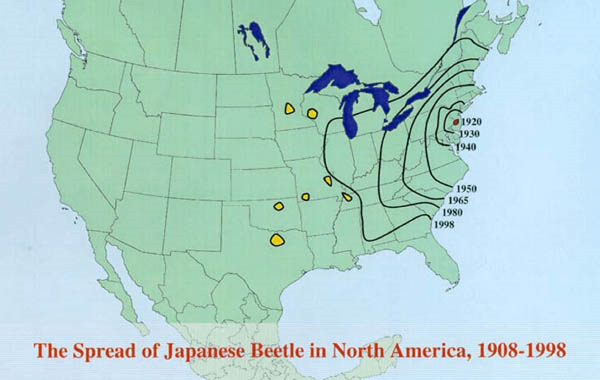
The spread of the Japanese beetle in North America. (Ohio State University, http://www.oardc.ohio-state.edu/biocontrol/images/jb_map.jpg)
Adult Japanese beetles are about 3/8-inch long, with metallic green bodies and coppery-brown front wings ("wing covers"). Five tufts of white hairs (white spots) are visible along each side of the abdomen, and a sixth pair of white tufts are visible at the tip of the abdomen. Larvae are typical C-shaped grubs, with three pairs of legs on the thorax and no legs or prolegs on the abdomen. Newly hatched larvae are about 1/16 inch long; mature larvae are about 1 1/4 inch long. Larvae of the Japanese beetle can be distinguished from larvae of other grub species by the V-shaped pattern of spines (the raster) at the tip of the abdomen.
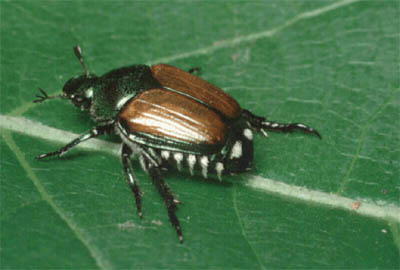
Adult Japanese beetle (University of Minnesota)
Mature larvae of the Japanese beetle pupate in the soil in late spring, and adults emerge from June through August. Females emit a sex pheromone to attract males, and mating occurs in the turf or other grasses where the female emerges; additional matings occur later on the plants on which adults feed. Adults find a suitable host plant, begin feeding, and both sexes emit an aggregation pheromone to attract other beetles to the same plant. Females feed, lay eggs in grassy areas, and return to host plants to mate and feed again, completing several cycles of this behavior. Each female lays 40 to 60 eggs. Because adult beetles can live for several weeks and emergence from pupae spans a period of several weeks as well, Japanese beetle adults may be present from June through September or October in at least some areas. Larvae hatch from eggs in July, August, and September, and they feed on the roots of grasses until cold temperatures trigger their movement downward in the soil to depths of 4 to 8 inches; they survive prolonged exposure to temperatures of 25 degrees F at that depth with little or no mortality. In the spring, partially grown larvae move upwards in the soil and resume feeding on roots. They pupate in May and June.
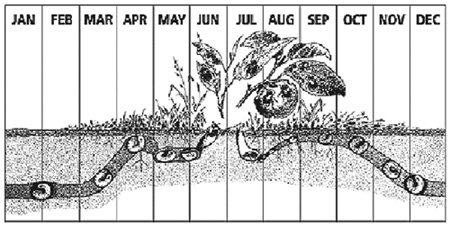
Japanese beetle life cycle. (Ohio State University)
Rick Weinzierl (217-244-2126; weinzier@illinois.edu)
Vegetable Production and Pest Management
Corn Earworm
Mike Roegge reported corn earworm moth counts in his pheromone trap peaked in late June and early July and have dropped some since then. The same trend occurred in southwestern Illinois near Collinsville and here at Urbana. Sweet corn and tomato growers should be operating a cone-shaped pheromone trap for corn earworm and devising spray plans accordingly for the remainder of the summer. See “Preseason Reminders for Corn Earworm Management in Sweet Corn” in the February 20 issue of this newsletter for more information.
Rick Weinzierl (217-244-2126; weinzier@illinois.edu)
Squash vine borer and squash bug
Squash vine borer and squash bugare active now. Some background on each …
The squash vine borer tunnels in the vines of pumpkins and summer and winter squash; it rarely is found in cucumbers or melons and cannot complete its development except in squash or pumpkins.
Identification. The squash vine borer adult is a black and reddish moth called a clearwing moth because large portions of its hind wings lack scales. These moths are ¾- to 1-inch long, with a 1- to 1 ½-inch wing span. They are active during the daytime and superficially resemble wasps as they fly about. Larvae are yellowish-white with a brown head, 3 pairs of thoracic legs, and 5 pairs of fleshy abdominal prolegs that bear tiny hooks called crochets. Fully-grown larvae are about 1 inch long. Brownish pupae are slightly less than 1 inch long, and they are found in the soil inside a dark, silken cocoon.
Life Cycle. Squash vine borers overwinter as mature larvae or pupae within cocoons 1 ½ to 3 inches below the soil surface. Moths emerge and begin to mate and lay eggs in June and July in much of the Midwest (earlier, beginning in May, in southern Illinois and similar latitudes). Moths lay eggs singly at the base of plants or on stems and petioles, beginning when plants start to bloom or “run”. Larvae feed within stems or petioles for 2 to 4 weeks, leaving brown, sawdust-like frass (droppings) at holes where they entered the stem. In southern Illinois these pupate and produce a second flight of moths in late summer; in the north, larvae or pupae of the first (and only) generation remain in the soil through the winter.
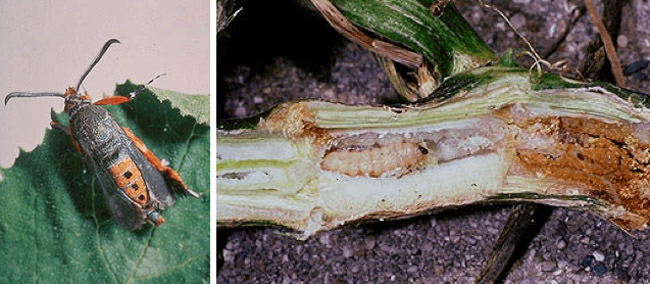
Squash vine borer adult (left) and larva (right)
Plant Injury. Tunneling within vines destroys water- and food-conducting tissues, reducing plant vigor and yield and sometimes killing vines.
Management. Disking or plowing to destroy vines soon after harvest and bury or destroy overwintering cocoons reduces moth populations within a field in the spring. Staggering plantings over several dates also allows some plantings to escape heaviest periods of egg-laying. Early detection of moths and initial damage is essential for timing insecticide applications. For insecticides to be effective, they must be applied before larvae enter stems or petioles. Scout for moths (pheromone lures and traps are available for monitoring flight periods) and look for entrance holes and frass as soon as plants begin to bloom or vine. Apply insecticides beginning 5 to7 days after moths are first detected and at weekly intervals for 3 to 5 weeks, or begin when injury is first noted and make a second application a week later. See the 2013 Midwest Vegetable Production Guide for listings of registered insecticides.
Late June and July usually bring the beginning of squash bug infestations in Illinois. The squash bug, Anasa tristis (De Geer) (Hemiptera: Coreidae), is a perennial and severe pest of pumpkins and squash; it rarely injures cucumbers and melons in the Midwestern United States.
Identification. The squash bug is a “true bug” in the order Hemiptera. Like all adult Hemiptera, adult squash bugs have two pairs of wings, with the front wings hardened at the base and membranous at the tips. Its mouthparts form a needle-like beak that arises from the tip of the head. Adults are brownish black, with yellowish to red-orange markings; they appear oval shaped when viewed from above, and somewhat flattened when viewed from the side. Females lay yellowish-white eggs in small clusters or masses on the upper and lower surfaces of leaves; the eggs quickly darken to a reddish brown color. Eggs hatch to produce grayish-white, wingless nymphs with black legs. The nymphs darken in color as they grow older, and wing pads (the beginnings of adult wings) begin to develop.
Life Cycle. The squash bug overwinters as an adult, and survival is greatest in plant debris, mulch, and field borders or woods. Adults become active in the spring, mate, and females begin feeding and laying eggs in June and July. Nymphs grow to the adult stage in 5 to 6 weeks, and new females mate and begin laying eggs immediately. Populations are greatest during hot, dry summers. Females that reach the adult stage after late July or early August do not mate or lay eggs but instead enter an inactive stage and seek overwintering sites. Squash bugs may be present as nymphs or adults in pumpkins and squash from June through October.
Plant Injury. Squash bugs use piercing mouthparts to penetrate stems, leaves, and fruit and suck sap from plants. This direct damage may cause wilting or even kill plants if populations are great enough. Recent research has found that squash bugs transmit squash yellow vine disease; controlling squash bugs limits the spread of this disease within fields.
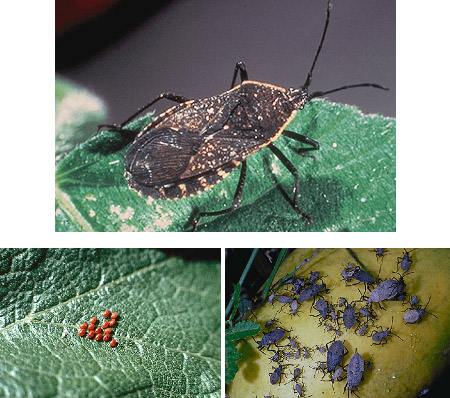
Squash bug adult (above), eggs (lower left), and nymphs (lower right).
Management. Early in the season when adults move into fields and feed on young plants, watch for wilting of seedlings and apply an insecticide if wilting is observed. Scout for eggs of the squash bug on upper and lower surfaces of leaves. If densities exceed one egg mass per plant, use insecticides for control as nymphs begin to hatch. Insecticides labeled for use against squash bug are most effective against young nymphs, and for commercial growers who possess a Pesticide Applicator’s License, the pyrethroid insecticides (particularly Brigade, Mustang Max, and Warrior) are most effective against squash bug. Organic growers may choose to use floating row covers to exclude squash bugs from young plants, but when row covers have to come off to allow pollination, none of the insecticides approved for use in Certified Organic production systems are truly effective against squash bugs. See the 2013 Midwest Vegetable Production Guide for listings of registered insecticides.
Rick Weinzierl (217-244-2126; weinzier@illinois.edu)
Colorado Potato Beetle
Kyle Cecil’s updates included remarks on Colorado potato beetles. Almost every year I receive one or more reports of Sevin, Endosulfan, and one or more pyrethroids to control Colorado potato beetle larvae in potatoes. These failures almost certainly result from insecticide resistance in the treated population.
Newer alternatives to which this insect has had less time to develop resistance include (for foliar application) Agri-Mek, Assail, Coragen, Entrust, Radiant, and Rimon. Novodor is effective against small larvae only. See the 2013 Midwest Vegetable Production Guide for a more complete listing of registered insecticides.
Thresholds for Colorado potato beetle control are based on the level of defoliation that plants withstand at different growth stages before significant yield losses occur. Treat if defoliation (loss of leaf area) exceeds the following levels at specified stages: preflowering – 20-30 percent; flowering -- 5-10 percent; tuber formation -- 30 percent.
Rick Weinzierl (217-244-2126; weinzier@illinois.edu)
Bean Leaf Beetle and Western Corn Rootworm Beetle
Some repetition from last month … all of these beetles may be found in Illinois vegetables now.
Among the many small beetles found in Illinois vegetable crops are the bean leaf beetle, striped cucumber beetle, spotted cucumber beetle, western rootworm beetle, and northern corn rootworm beetle. Although these beetles are somewhat similar in appearance, distinguishing among them is important. The cucumber beetles are vectors of the pathogen that causes bacterial wilt of cucumbers and muskmelons; the others are not. Bean leaf beetles are more likely to cause serious damage to beans than the other species (although spotted cucumber beetle will feed on bean foliage and pods). Here is a repeat of the key characters that help in identifying these species.

Left to right: bean leaf beetles, spotted cucumber beetle, striped cucumber beetle.
Bean leaf beetles vary in color and marking, some with black spots or bars on the elytra (shell-like forewings), and some without these marks. All are marked with a black wedge immediately behind the prothorax. Spotted cucumber beetles resemble bean leaf beetles but always have 12 distinct spots on the wings. The front, center spots are distinct and do not form a triangle as they do on the bean leaf beetle. Striped cucumber beetles have distinct black stripes along the inner and outer edges of the wings, and the stripes run all the way to the ends of the wings. The underside of the abdomen is black. All of these insects overwinter as adults and move into fields and gardens in April through May, as soon as temperatures warm up and their food plants become available. They lay eggs at the base of their host plants, and larvae develop below ground, feeding on the roots. One or two summer generations of adults of these species emerge and feed, mate, and lay eggs; adults of the latter of these summer generations overwinter.
Western corn rootworm beetles resemble striped cucumber beetles because of the stripes on their wings. The edges of these stripes tend blur or fade on the western corn rootworm, and they do not extend all the way to ends of the wings. The underside of the abdomen of the western corn rootworm is yellowish. Northern corn rootworm beetles have no stripes and no spots ... they're uniformly yellowish green. These two species overwinter as eggs in the soil. Larvae that hatch in the spring feed on the roots of corn, then eventually pupate and emerge as adults, usually beginning in July. Western and northern corn rootworm adults undergo just one generation per year. The adults present in later summer and fall mate, and females lay eggs in the soil; those eggs overwinter to start the cycle again the next spring.
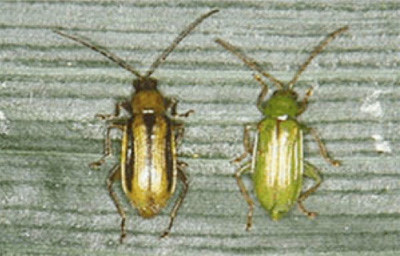
Western (left) and northern (right) corn rootworm beetles.
Western corn rootworm beetles are extremely abundant in many areas now. In sweet corn, feeding by adults on silks may reduce successful pollination, and control is necessary where silk clipping is heavy.
Rick Weinzierl (217-244-2126; weinzier@illinois.edu)
Local Foods Issues
High tunnel end walls: coping with strong winds
High tunnels are increasingly popular for production of fruits and vegetables. One disadvantage of high tunnels is that they can be destroyed by high winds, snow, and ice, as they typically do not have the strength of greenhouse structures.
High tunnel kits come with instructions on how to erect them. The often recommended zippable plastic entrance is particularly easily unzipped by strong winds and the unintended opening adds to the likelihood of greater damage.

A better way to deal with end walls is to design a framework-reinforced end wall with an entry door and a bigger doorway that can allow a small tiller/tractor to enter into the high tunnel (see below).
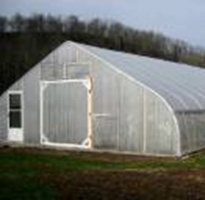
Todd and Julia McDonald (www.peasantsplot.com) in Manteno recommend framing out the end walls and then installing polycarbonate plastic ends. To help with wind damage/ripping of the plastic film, it seems that doubling up a little extra bit of plastic at the wiggle wire helps to reduce tearing at the wiggle wire.
Extension educator and high tunnel grower Mike Roegge has a few tips as well. A tunnel can use several options for end walls: polycarbonate is one option, but most producers do not want that extra expense, and therefore opt for 6 mil plastic or the zippered plastic referred to above. On zippered end walls (and plastic end walls) Mike has found that one cannot rely upon the zippers to allow for entry/exit. In addition, he recommends having an entrance door. He found that using wood framing helps keep the zippers from failing. The zippers fail due to wind stress. So as to provide some support to prevent wind stress on his tunnel, he placed two 2x4’s into a “T” and secured them together with deck screws to help prevent warping. He then attached one end of these to the end base and the other end to the end arch. This was on the inside of the tunnel. On the outside he used deck screws to attach 1” lattice to hold the plastic end walls to the 2 x 4’s. Then during the summer he completely opens up the ends, allowing wind to blow through. It is also important to use something like WD-40 on the zippers every once in a while to lube them. They open and close much more easily then.
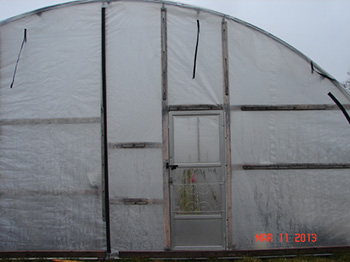
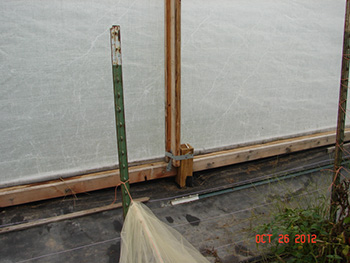
Depending upon how the end walls are designed, by opening them one can gain entrance to the high tunnel with a small tractor/tiller, etc. and therefore it may not be necessary to build a doorway to accommodate those bigger machines.
James Theuri (815-933-8337; jtheu50@illinois.edu)
Traceability, Recall, and Recordkeeping
Traceability is the ability to verify the history, location, or application of an item by means of documented recorded identification. Traceability is an important aspect in the food industry where it contributes to food safety. Food safety and quality have become increasingly important world-wide in recent years, not only in terms of protecting the health of the consumer, but also to meet requirements for international trade. Control of food safety and quality requires the ability to trace the authentic source of food. Failure to do so can have severe economic backlashes and the potential to cause foodborne illnesses.
Traceability touches on various stakeholder interests: consumers are concerned that their food is safe to eat and correctly labeled; retailers are concerned that the food is not adulterated, and legislators that food safety parameters have been met. In order to trace food sources, proper records must be kept at every step along the food chain, from farm to point of sale. At each step along the chain, there should be records indicating where the food came from (one step back) and where it went to (one step forward). Simple technologies (such as barcodes, unique to each farm) have reduced the time and amount of labor that would be required to manually do the job. In the event that a foodborne disease outbreak has happened, ability to trace the infectious food as fast as possible is critical, and if possible it should be done in a few hours. Meanwhile, the unconsumed culprit food commodity is quickly recalled before other people (or animals) consume the product.
The Food Safety Modernization Act requires food producers to include traceability procedures in their operations. The Act stipulates the need for recordkeeping and mock recalls to ensure that if a foodborne outbreak happened, traceability and removal of affected food commodity could be done efficiently.
James Theuri (815-933-8337; jtheu50@illinois.edu)
Mice, Voles, and More
Our production fields are home to more than just the crops we grow. Many wildlife species use our fields as their homes, while others may simply pass through or fly by. These unwelcome guests not only damage produce but can also leave behind potential sources of microbial contamination in their manure.
Can we keep all of them out? Probably not. Therefore, Good Agricultural Practices encourages farmers to be aware of potential risk, work to exclude animals and have a plan in place when animals find their way into production fields. There are many possible controls available, depending on the type of animal. Fencing, scare tactics, depredation and/or modification of the surrounding environment are potential management measures. For more information on typical Illinois wildlife and ideas on controlling them, check out the Living with Wildlife website at http://web.extension.illinois.edu/wildlife/.
Since it is impossible to keep every mouse out of our fields, it is important to train employees to watch out for evidence of wild animals such as eaten produce or droppings. Having protocol to follow is part of a Food Safety Plan. What if droppings are found in a field or on produce? The protocol could be that the feces are immediately removed and disposed of away from field. The area would be flagged, designating the number of feet from the flag that should not be harvested or simply removing the plants completely.
Being aware of wildlife and trying to control their impact in field and packing house is only one part of a Food Safety Plan.
Ellen Phillips (708-449-4320; ephillps@illinois.edu)
University of Illinois Extension Specialists in Fruit and Vegetable Production & Pest Management
Extension Educators – Local Food Systems and Small Farms |
||
Bronwyn Aly, Gallatin, Hamilton, Hardin, Pope, Saline, and White counties |
618-382-2662 |
|
Katie Bell, Franklin, Jackson, Perry, Randolph, & Williamson counties |
618-687-1727 |
|
Sarah Farley, Lake & McHenry counties |
847-223-8627 |
|
Nick Frillman, Woodford, Livingston, & McLean counties |
309-663-8306 |
|
Laurie George, Bond, Clinton, Jefferson, Marion, & Washington counties |
618-548-1446 |
|
Zachary Grant, Cook County | 708-679-6889 | |
Doug Gucker, DeWitt, Macon, and Piatt counties |
217-877-6042 |
|
Erin Harper, Champaign, Ford, Iroquois, and Vermillion counties |
217-333-7672 |
|
Grace Margherio, Jackie Joyner-Kersee Center, St. Clair County |
217-244-3547 |
|
Grant McCarty, Jo Daviess, Stephenson, and Winnebago counties |
815-235-4125 |
|
Katie Parker, Adams, Brown, Hancock, Pike and Schuyler counties |
217-223-8380 |
|
Kathryn Pereira, Cook County |
773-233-2900 |
|
James Theuri, Grundy, Kankakee, and Will counties |
815-933-8337 |
|
Extension Educators – Horticulture |
||
Chris Enroth, Henderson, Knox, McDonough, and Warren counties |
309-837-3939 |
|
Richard Hentschel, DuPage, Kane, and Kendall counties |
630-584-6166 |
|
Andrew Holsinger, Christian, Jersey, Macoupin, & Montgomery counties |
217-532-3941 |
|
Extension Educators - Commercial Agriculture |
||
Elizabeth Wahle, Fruit & Vegetable Production |
618-344-4230 |
|
Nathan Johanning, Madison, Monroe & St. Clair counties |
618-939-3434 |
|
Campus-based Extension Specialists |
||
Kacie Athey, Entomology |
217-244-9916 |
|
Mohammad Babadoost, Plant Pathology |
217-333-1523 |
|